Yuhang Lu
Mitigating Message Imbalance in Fraud Detection with Dual-View Graph Representation Learning
Jul 09, 2025Abstract:Graph representation learning has become a mainstream method for fraud detection due to its strong expressive power, which focuses on enhancing node representations through improved neighborhood knowledge capture. However, the focus on local interactions leads to imbalanced transmission of global topological information and increased risk of node-specific information being overwhelmed during aggregation due to the imbalance between fraud and benign nodes. In this paper, we first summarize the impact of topology and class imbalance on downstream tasks in GNN-based fraud detection, as the problem of imbalanced supervisory messages is caused by fraudsters' topological behavior obfuscation and identity feature concealment. Based on statistical validation, we propose a novel dual-view graph representation learning method to mitigate Message imbalance in Fraud Detection(MimbFD). Specifically, we design a topological message reachability module for high-quality node representation learning to penetrate fraudsters' camouflage and alleviate insufficient propagation. Then, we introduce a local confounding debiasing module to adjust node representations, enhancing the stable association between node representations and labels to balance the influence of different classes. Finally, we conducted experiments on three public fraud datasets, and the results demonstrate that MimbFD exhibits outstanding performance in fraud detection.
Pose-invariant face recognition via feature-space pose frontalization
May 22, 2025Abstract:Pose-invariant face recognition has become a challenging problem for modern AI-based face recognition systems. It aims at matching a profile face captured in the wild with a frontal face registered in a database. Existing methods perform face frontalization via either generative models or learning a pose robust feature representation. In this paper, a new method is presented to perform face frontalization and recognition within the feature space. First, a novel feature space pose frontalization module (FSPFM) is proposed to transform profile images with arbitrary angles into frontal counterparts. Second, a new training paradigm is proposed to maximize the potential of FSPFM and boost its performance. The latter consists of a pre-training and an attention-guided fine-tuning stage. Moreover, extensive experiments have been conducted on five popular face recognition benchmarks. Results show that not only our method outperforms the state-of-the-art in the pose-invariant face recognition task but also maintains superior performance in other standard scenarios.
RenderWorld: World Model with Self-Supervised 3D Label
Sep 17, 2024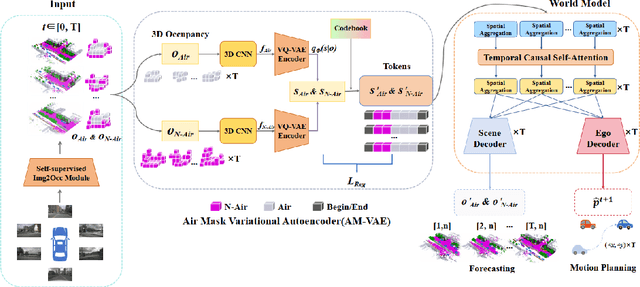
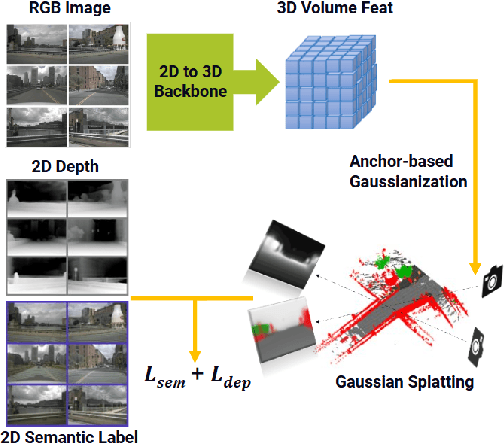


Abstract:End-to-end autonomous driving with vision-only is not only more cost-effective compared to LiDAR-vision fusion but also more reliable than traditional methods. To achieve a economical and robust purely visual autonomous driving system, we propose RenderWorld, a vision-only end-to-end autonomous driving framework, which generates 3D occupancy labels using a self-supervised gaussian-based Img2Occ Module, then encodes the labels by AM-VAE, and uses world model for forecasting and planning. RenderWorld employs Gaussian Splatting to represent 3D scenes and render 2D images greatly improves segmentation accuracy and reduces GPU memory consumption compared with NeRF-based methods. By applying AM-VAE to encode air and non-air separately, RenderWorld achieves more fine-grained scene element representation, leading to state-of-the-art performance in both 4D occupancy forecasting and motion planning from autoregressive world model.
Can LVLMs Obtain a Driver's License? A Benchmark Towards Reliable AGI for Autonomous Driving
Sep 04, 2024Abstract:Large Vision-Language Models (LVLMs) have recently garnered significant attention, with many efforts aimed at harnessing their general knowledge to enhance the interpretability and robustness of autonomous driving models. However, LVLMs typically rely on large, general-purpose datasets and lack the specialized expertise required for professional and safe driving. Existing vision-language driving datasets focus primarily on scene understanding and decision-making, without providing explicit guidance on traffic rules and driving skills, which are critical aspects directly related to driving safety. To bridge this gap, we propose IDKB, a large-scale dataset containing over one million data items collected from various countries, including driving handbooks, theory test data, and simulated road test data. Much like the process of obtaining a driver's license, IDKB encompasses nearly all the explicit knowledge needed for driving from theory to practice. In particular, we conducted comprehensive tests on 15 LVLMs using IDKB to assess their reliability in the context of autonomous driving and provided extensive analysis. We also fine-tuned popular models, achieving notable performance improvements, which further validate the significance of our dataset. The project page can be found at: \url{https://4dvlab.github.io/project_page/idkb.html}
Towards A Comprehensive Visual Saliency Explanation Framework for AI-based Face Recognition Systems
Jul 08, 2024
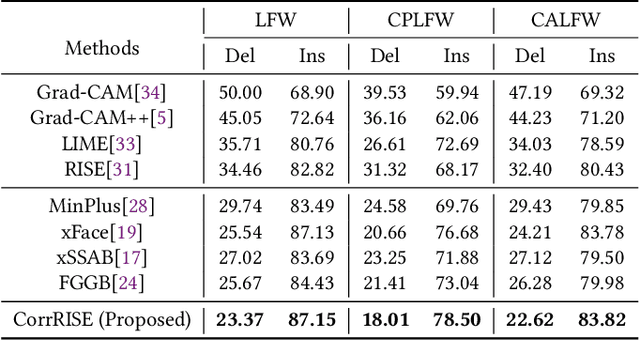
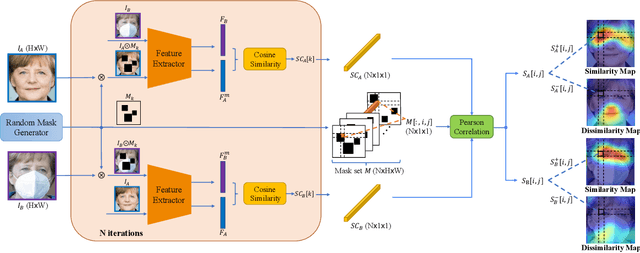

Abstract:Over recent years, deep convolutional neural networks have significantly advanced the field of face recognition techniques for both verification and identification purposes. Despite the impressive accuracy, these neural networks are often criticized for lacking explainability. There is a growing demand for understanding the decision-making process of AI-based face recognition systems. Some studies have investigated the use of visual saliency maps as explanations, but they have predominantly focused on the specific face verification case. The discussion on more general face recognition scenarios and the corresponding evaluation methodology for these explanations have long been absent in current research. Therefore, this manuscript conceives a comprehensive explanation framework for face recognition tasks. Firstly, an exhaustive definition of visual saliency map-based explanations for AI-based face recognition systems is provided, taking into account the two most common recognition situations individually, i.e., face verification and identification. Secondly, a new model-agnostic explanation method named CorrRISE is proposed to produce saliency maps, which reveal both the similar and dissimilar regions between any given face images. Subsequently, the explanation framework conceives a new evaluation methodology that offers quantitative measurement and comparison of the performance of general visual saliency explanation methods in face recognition. Consequently, extensive experiments are carried out on multiple verification and identification scenarios. The results showcase that CorrRISE generates insightful saliency maps and demonstrates superior performance, particularly in similarity maps in comparison with the state-of-the-art explanation approaches.
Explainable Face Verification via Feature-Guided Gradient Backpropagation
Mar 07, 2024Abstract:Recent years have witnessed significant advancement in face recognition (FR) techniques, with their applications widely spread in people's lives and security-sensitive areas. There is a growing need for reliable interpretations of decisions of such systems. Existing studies relying on various mechanisms have investigated the usage of saliency maps as an explanation approach, but suffer from different limitations. This paper first explores the spatial relationship between face image and its deep representation via gradient backpropagation. Then a new explanation approach FGGB has been conceived, which provides precise and insightful similarity and dissimilarity saliency maps to explain the "Accept" and "Reject" decision of an FR system. Extensive visual presentation and quantitative measurement have shown that FGGB achieves superior performance in both similarity and dissimilarity maps when compared to current state-of-the-art explainable face verification approaches.
Towards the Detection of AI-Synthesized Human Face Images
Feb 13, 2024Abstract:Over the past years, image generation and manipulation have achieved remarkable progress due to the rapid development of generative AI based on deep learning. Recent studies have devoted significant efforts to address the problem of face image manipulation caused by deepfake techniques. However, the problem of detecting purely synthesized face images has been explored to a lesser extent. In particular, the recent popular Diffusion Models (DMs) have shown remarkable success in image synthesis. Existing detectors struggle to generalize between synthesized images created by different generative models. In this work, a comprehensive benchmark including human face images produced by Generative Adversarial Networks (GANs) and a variety of DMs has been established to evaluate both the generalization ability and robustness of state-of-the-art detectors. Then, the forgery traces introduced by different generative models have been analyzed in the frequency domain to draw various insights. The paper further demonstrates that a detector trained with frequency representation can generalize well to other unseen generative models.
OctreeOcc: Efficient and Multi-Granularity Occupancy Prediction Using Octree Queries
Dec 09, 2023Abstract:Occupancy prediction has increasingly garnered attention in recent years for its fine-grained understanding of 3D scenes. Traditional approaches typically rely on dense, regular grid representations, which often leads to excessive computational demands and a loss of spatial details for small objects. This paper introduces OctreeOcc, an innovative 3D occupancy prediction framework that leverages the octree representation to adaptively capture valuable information in 3D, offering variable granularity to accommodate object shapes and semantic regions of varying sizes and complexities. In particular, we incorporate image semantic information to improve the accuracy of initial octree structures and design an effective rectification mechanism to refine the octree structure iteratively. Our extensive evaluations show that OctreeOcc not only surpasses state-of-the-art methods in occupancy prediction, but also achieves a 15%-24% reduction in computational overhead compared to dense-grid-based methods.
See More and Know More: Zero-shot Point Cloud Segmentation via Multi-modal Visual Data
Jul 20, 2023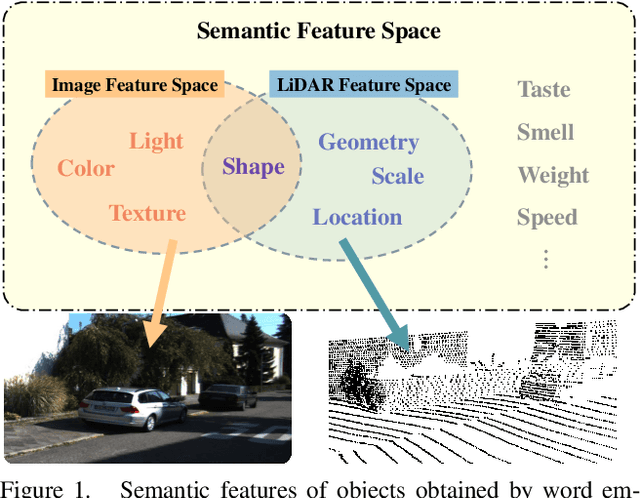
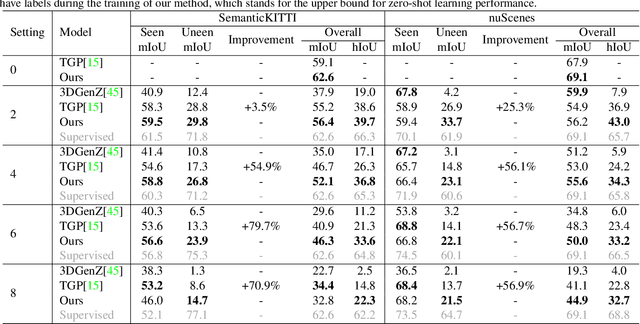
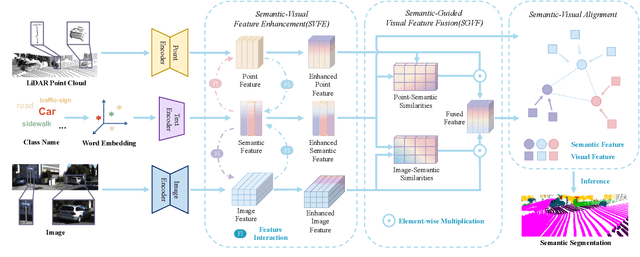
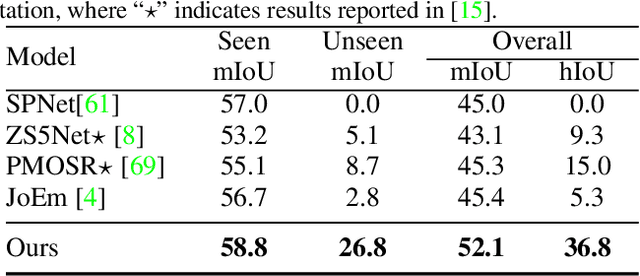
Abstract:Zero-shot point cloud segmentation aims to make deep models capable of recognizing novel objects in point cloud that are unseen in the training phase. Recent trends favor the pipeline which transfers knowledge from seen classes with labels to unseen classes without labels. They typically align visual features with semantic features obtained from word embedding by the supervision of seen classes' annotations. However, point cloud contains limited information to fully match with semantic features. In fact, the rich appearance information of images is a natural complement to the textureless point cloud, which is not well explored in previous literature. Motivated by this, we propose a novel multi-modal zero-shot learning method to better utilize the complementary information of point clouds and images for more accurate visual-semantic alignment. Extensive experiments are performed in two popular benchmarks, i.e., SemanticKITTI and nuScenes, and our method outperforms current SOTA methods with 52% and 49% improvement on average for unseen class mIoU, respectively.
Discriminative Deep Feature Visualization for Explainable Face Recognition
Jun 01, 2023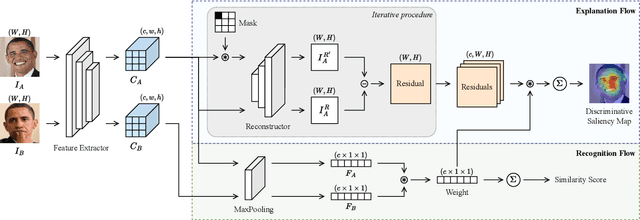
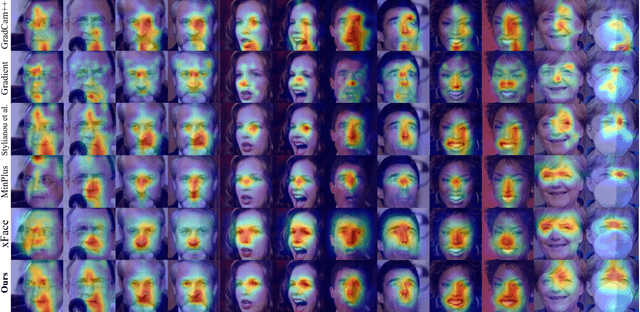
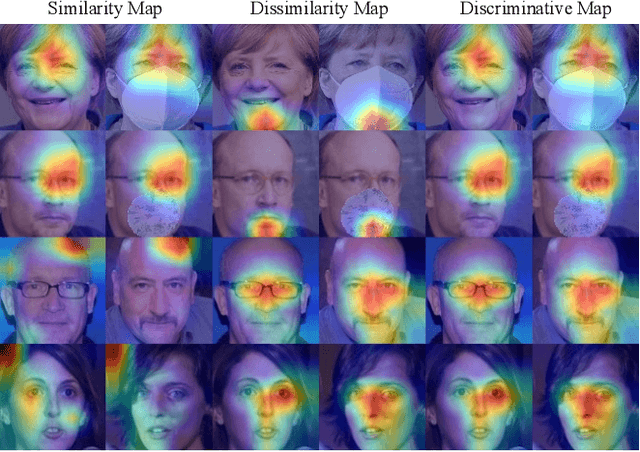
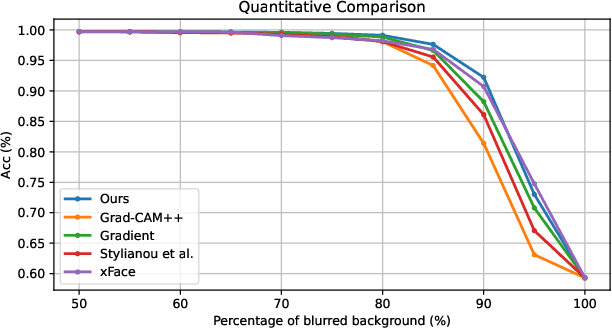
Abstract:Despite the huge success of deep convolutional neural networks in face recognition (FR) tasks, current methods lack explainability for their predictions because of their "black-box" nature. In recent years, studies have been carried out to give an interpretation of the decision of a deep FR system. However, the affinity between the input facial image and the extracted deep features has not been explored. This paper contributes to the problem of explainable face recognition by first conceiving a face reconstruction-based explanation module, which reveals the correspondence between the deep feature and the facial regions. To further interpret the decision of an FR model, a novel visual saliency explanation algorithm has been proposed. It provides insightful explanation by producing visual saliency maps that represent similar and dissimilar regions between input faces. A detailed analysis has been presented for the generated visual explanation to show the effectiveness of the proposed method.
 Add to Chrome
Add to Chrome Add to Firefox
Add to Firefox Add to Edge
Add to Edge